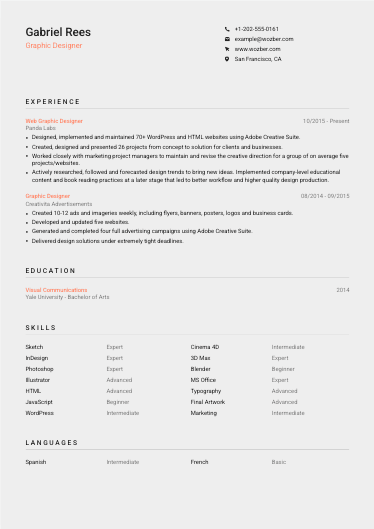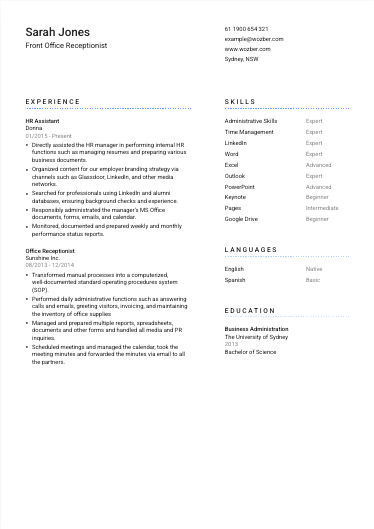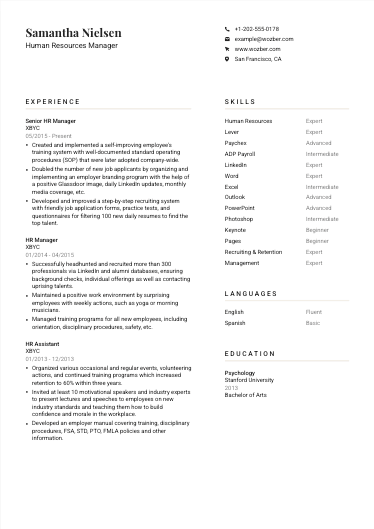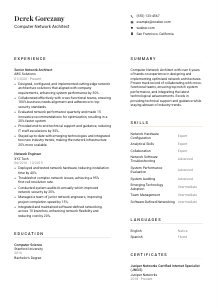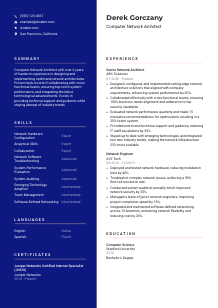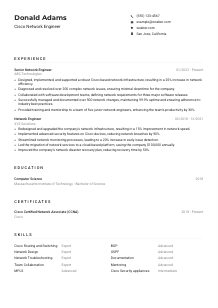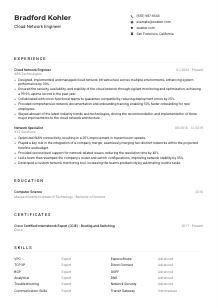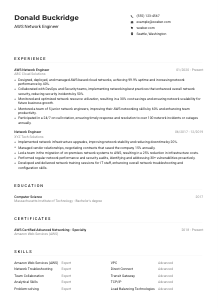Computer Network Architect CV Example
Designing digital pathways, but your CV feels like loading bars? Navigate this Computer Network Architect CV example, arranged with Wozber free CV builder. Discover how to map your network wizardry to job terrain, ensuring your career connection is strong and steady, with no buffering!
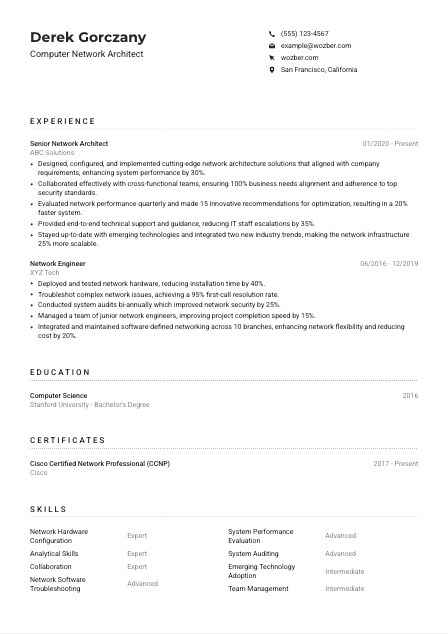
How to write a Computer Network Architect CV?
Embarking on the journey to land your dream job as a Computer Network Architect? Your CV is the key that unlocks the door to this coveted role. Through the lens of the job description provided, let's navigate the specifics of tailoring your CV with precision. Harnessing the power of Wozber's free CV builder, which includes access to ATS-friendly CV templates and an ATS CV scanner, this guide will be your compass.
Ready to roll up your sleeves and construct a CV that not only passes the ATS but also lands on the hiring manager's desk? Let's dive in and ensure your digital network skills are vividly and meticulously showcased.
Personal Details
In a digitally interconnected world, the Personal Details section is the IP address of your CV - it's how employers locate you. While it seems straightforward, let's infuse it with as much forethought as routing an optimal network pathway.
1. Brand Yourself
Start with clarity in your identification. Just as a well-named server eases identification, ensure your name stands out with a clear and professional font.
2. Job Title Alignment
Directly below your name, echoing the job title "Computer Network Architect" immediately frames the context of your application, much like specifying the protocol before the port in a network configuration.
3. Essential Contact Hex
In the digital realm, every number counts. Use a reliable phone number and a professional email address formatted as firstname.lastname@email.com, much like how crucial syntax is in a configuration script.
4. Geo-Tag
"San Francisco, California" is more than a location; it's a requirement ticked. Including it signals to the hiring manager that you're in the network range, avoiding potential latency in commuting or relocation considerations.
5. Professional Ports
Consider adding LinkedIn or a personal website to your contact section. Ensure they're up-to-date and reflect your professional narrative as accurately as a well-documented network diagram.
Takeaway
Think of the Personal Details section as your network handshake protocol – it's the initiation of a professional connection. Precision and clarity here set the tone for a successful data exchange. It's your first hop in the network of application evaluation; make sure it's optimised for smooth transmission.





Experience
Your experience is the bandwidth of your CV, showcasing the data throughput of your career so far. It's time to optimise this section by throttling your achievements and responsibilities in line with the Computer Network Architect's job specifications. Let's configure your professional journey for peak performance.
- Designed, configured, and implemented cutting‑edge network architecture solutions that aligned with company requirements, enhancing system performance by 30%.
- Collaborated effectively with cross‑functional teams, ensuring 100% business needs alignment and adherence to top security standards.
- Evaluated network performance quarterly and made 15 innovative recommendations for optimisation, resulting in a 20% faster system.
- Provided end‑to‑end technical support and guidance, reducing IT staff escalations by 35%.
- Stayed up‑to‑date with emerging technologies and integrated two new industry trends, making the network infrastructure 25% more scalable.
- Deployed and tested network hardware, reducing installation time by 40%.
- Troubleshot complex network issues, achieving a 95% first‑call resolution rate.
- Conducted system audits bi‑annually which improved network security by 25%.
- Managed a team of junior network engineers, improving project completion speed by 15%.
- Integrated and maintained software‑defined networking across 10 branches, enhancing network flexibility and reducing cost by 20%.
1. Requirement Routing
Analogous to setting up a routing protocol, dissect the job requirements to ensure your accomplishments flow in the same direction. This involves a detailed analysis of the job posting to highlight your relevant experiences.
2. Infrastructure Layout
Draft your experience in a chronological framework, starting with your most recent position. This layout echoes the logical progression of a network topology, offering recruiters an intuitive flow of your career progression.
3. Optimal Packet Content
For every role listed, encapsulate your achievements and responsibilities in bullet points. Think of each bullet as a data packet, containing concise and impactful information about your contributions and enhancements to the network's performance.
4. Quantify Traffic
Wherever possible, quantify your achievements. Use metrics like percentages or tangible outcomes to demonstrate the impact of your work, akin to showcasing throughput improvements or latency reductions in a network.
5. Filter Out Noise
Akin to applying a traffic filter on a busy network, ensure only the most relevant experiences are transmitted. This keeps the hiring manager's attention focused on the specifications that matter most.
Takeaway
Curating your experience with a focus on relevance and impact is akin to fine-tuning a network for optimal performance. Make every bullet point count, ensuring you clearly communicate how you've solved problems and added value in past roles. Demonstrate how your professional bandwidth makes you the prime candidate for routing through to the interview stage.
Education
For a Computer Network Architect, the education section forms the foundational protocol stack of your CV. Displaying your academic credentials effectively can be as crucial as having the correct routing protocols in place for network operations.
1. Highlight the Protocol
Zero in on the 'Bachelor's degree in Computer Science, Information Technology, or a related field' as specified in the job description. This frames your educational background within the required parameters, akin to setting the basic configuration for a network device.
2. Configuration Syntax
Keep the education section syntax simple and structured: Degree title, School name, Graduation date. Think of this as the structured cabling that underpins your academic achievements.
3. Degree-Application Mapping
Ensure your degree, particularly 'Bachelor's Degree in Computer Science' from the example, matches the job requirements exactly. This is your SSL certificate, proving encryption between your qualifications and the job's demands.
4. Advanced Configuration
List any relevant courses or certifications here if they add value to your application, much like how additional modules or plugins can enhance the functionality of a network appliance.
5. Network Enhancements
Consider mentioning any extracurricular activities or achievements that highlight your comprehensive skill set and well-rounded character, similar to how a well-documented network has thorough backups and failovers.
Takeaway
A solid education section shouldn't just meet the basic requirements. It should affirm your base knowledge and offer insight into your broader capabilities and interests. Think of it as the core layer of your professional network stack - foundational, critical, and indicative of your potential to handle advanced network architectures.
Certificates
The world of Computer Network Architecture is ever-evolving, and possessing the right certifications is like having the latest firmware update; it keeps you relevant and competitive. Let's dive into how we can showcase your continuous learning in a domain that thrives on advancements.
1. Identify Required Upgrades
Start by pinpointing certificates that align with the job description. The mention of 'Cisco Certified Network Professional (CCNP)' and 'Juniper Networks Certified Internet Specialist (JNCIS)' in the job description acts as a beacon. Highlighting these certifications showcases your alignment with industry standards and job-specific skills.
2. Firmware Selection
While a comprehensive list of all your certifications might be tempting, focus on those most relevant to the job at hand. Quality trumps quantity, ensuring the hiring manager immediately sees your fit for the role, as succinctly as a well-commented config script.
3. Update Logs
If your certifications have a validity period or if they're recent achievements, it's beneficial to include these dates. This transparency is akin to maintaining a current software version, proving your ongoing commitment to staying up-to-date with industry trends and standards.
4. Continuous Learning Protocol
In the fast-paced digital world, ongoing education is key. Regularly updating your certifications and seeking new learning opportunities demonstrate your dedication to your professional development, much like how regular network assessments ensure optimal performance.
Takeaway
Your certifications are not just accolades; they are proof of your commitment to professional growth and understanding of complex network architectures. Treat this section as a signal boost for your CV, ensuring it transmits the right frequencies to catch the hiring manager's attention. Let it show that you're not only keeping pace with the technology but are also poised to lead in tomorrow's networking challenges.
Skills
The Skills section of your CV is your interface configuration - it's where you detail the protocols and technologies you're proficient with. For a Computer Network Architect, it's critical to communicate both your technical prowess and your soft skills in a format that's as streamlined and efficient as a high-speed network.
1. Protocol Analysis
Dive into the job description to distinguish both the explicit and implicit skills required. Pinpointing skills like 'Network Hardware Configuration' and 'Analytical Skills' directly mirrors the job's needs, showcasing your capabilities in both the technical and cognitive realms.
2. Highlight Configuration
Concentrate on skills that align precisely with the job description. By articulating your proficiency in areas like 'Collaboration' and 'System Performance Evaluation', you demonstrate your capacity to not only work within the technical specifications but also to enhance and optimise network performance.
3. Organize Your Interface
Resist the temptation to list every skill you've ever acquired. Instead, meticulously curate your list to spotlight the most relevant skills, ensuring the hiring manager doesn't have to navigate through unnecessary information to find what they're looking for.
Takeaway
Your Skills section is an opportunity to broadcast your technical and interpersonal abilities. Carefully selected and well-presented, these skills confirm your aptitude for the role. Ensure this part of your CV is finely tuned, like a high-performing network, to communicate your value at a glance. Let each skill be a node in the network of your professional persona, interlinked and working in concert to support your candidature.
Languages
In our increasingly interconnected world, proficiency in multiple languages is akin to supporting multiple protocols in a network - it enhances communication and broadens the scope of your interactions. Let's articulate your linguistic capabilities in a way that accentuates your versatility.
1. Global Communication Configuration
Initiate with a thorough examination of the job requirements. The job description emphasizes 'Proficiency in English.' This becomes your primary communication protocol. List it first and categorize your proficiency accurately.
2. Additional Protocol Support
After listing the primary language (English) with its proficiency level (Native), include any additional languages you speak. This demonstrates your versatility and capability to operate in diverse environments, much like how a network device supports multiple protocols.
3. Honesty in Bandwidth
Be clear and honest about your language proficiency levels. Like network speeds, it's better to promise and deliver consistently rather than overstate and underperform. This honesty builds trust with potential employers from the outset.
4. Analyze the Network Scope
Consider the role's geographic and demographic context. For a position with potential for global interaction, additional language skills could significantly bolster your application, showcasing your ability to communicate across different network segments.
5. Keep Updating Your Language Packets
Learning languages is a continual process, much like staying abreast of new technologies in network architecture. Indicate ongoing language learning to show your commitment to personal and professional growth.
Takeaway
Your CV is more than a document; it's a communication protocol designed to interface with prospective employers. Your languages are the protocols within, enabling you to communicate across various layers and domains. Even if a language seems peripheral to the role at hand, it enhances your overall profile, offering a broader bandwidth for interpersonal and global engagement.
Summary
Crafting a captivating summary is comparable to designing an efficient network topology - it must be both comprehensive and succinct, ensuring that data flow (or in this case, reader interest) is optimised. Here's how to encapsulate your experience, skills, and professional ethos in a few compelling lines.
1. Capture Protocol Essentials
Commence with a robust understanding of the job description, using it to frame your introduction. Highlight your professional identity and core expertise, positioning yourself as a solution to the company's network architecture needs.
2. Command and Control
Deploy a few carefully chosen highlights from your career to address key job requirements. Just as in network administration, where strategic points of control ensure smooth traffic, select achievements that demonstrate your capacity to enhance network efficiency and security.
3. Optimise Your Signal
Remember, conciseness is key. Keep your summary focused and impactful, ideally within 3-5 sentences, to maintain the hiring manager's attention - much like how a well-configured firewall maintains network integrity by filtering out irrelevant traffic.
4. Broadcast Your Unique SSID
End with a statement that reflects your unique professional identity or career goals. It's the SSID of your CV - a unique identifier that sets you apart in the sea of network professionals.
Takeaway
Your summary is the control packet in your CV's data stream. It encapsulates your value as a Computer Network Architect, signaling to the hiring manager why you are the right candidate for their network's architecture. Sharp, concise, and reflective of both your skills and the job's requirements, the summary ensures you're multicast across the hiring landscape, reaching the targeted destinations. Remember, Wozber's free CV builder is designed to help you craft an ATS-compliant CV, from the use of ATS-friendly CV templates to ATS optimisation. Let your CV be your broadcast, signaling your readiness to connect, configure, and create within the realm of Computer Network Architecture.
Your Journey as a Computer Network Architect
You've now navigated through the intricate pathways of crafting a standout CV for a Computer Network Architect position. Each section, carefully optimised and tailored, speaks volumes of your expertise and readiness to tackle the challenges of the role. Wozber is here to support your journey, offering free access to ATS-friendly CV templates and an ATS CV scanner to ensure your document is primed for success. Remember, your CV is more than a series of entries; it's a testament to your career, a reflection of your professional journey, and a beacon towards your future aspirations.
Let it resonate with clarity and purpose. The network of your career awaits expansion; embark with confidence and the best tools at your disposal. Your next professional milestone is just a connection away.

- Bachelor's degree in Computer Science, Information Technology, or a related field.
- Minimum of 5 years of experience in network design and implementation.
- Proficiency in network hardware and software configuration, installation, troubleshooting, and best practices.
- Strong analytical and problem-solving skills with the ability to work both independently and collaboratively in a team environment.
- Relevant industry certifications such as Cisco Certified Network Professional (CCNP) or Juniper Networks Certified Internet Specialist (JNCIS) are highly preferred.
- Proficiency in English is key.
- Candidate must be located in San Francisco, California.
- Design, configure, and implement optimized network architecture solutions based on company requirements.
- Collaborate with cross-functional teams to ensure network solutions align with business needs and security standards.
- Regularly evaluate network performance and make recommendations for improvement, upgrades, or changes.
- Provide technical support and guidance to IT staff and end users.
- Stay updated with emerging technologies and industry trends to ensure network infrastructure remains up-to-date and scalable.

